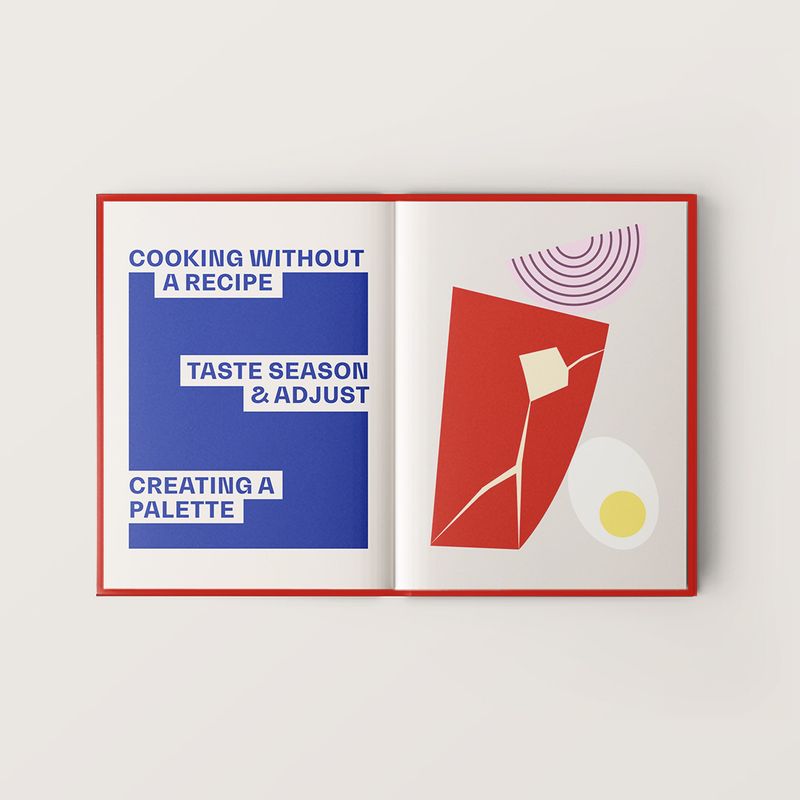
Cooking + Creativity
Cooking without recipes isn't just a process, it's a mindset. Designer + Animator Kasella Acain writes about experimentation in the kitchen and in design.
“Cooking is just as creative and imaginative an activity as drawing, or wood carving, or music. And cooking draws upon your every talent—science, mathematics, energy, history, experience—and the more experience you have, the less likely are your experiments to end in drivel and disaster. The more you know, the more you can create.”
–Julia Child
During quarantine, I was searching for ways to occupy the long days spent at home. Like many, I found myself in the kitchen, Googling how to make a roux or asking my mom for step-by-step recipes from my childhood. At the time, I had just graduated from college and was living at home. No longer eating dorm food or microwaved meals, I found myself enjoying the process of experimenting with recipes and sharing food with others.
I’ve picked up a few lessons from cooking that have, to my surprise, helped shape how I think about design and animation, and understand what’s important to me. It’s about taking the time to care about the details. Whether it’s mise en place—getting organized before diving head first into animating—or simmering a three-hour stock from scratch—like designing a custom typeface—it’s a love of craft that really enriches the final product.
The creative process is like cooking
Cooking starts off in a similar way to design. It starts with big ideas, raw ingredients, and endless possibilities; the “dish” only begins to take shape once you’ve narrowed things down. In cooking, it begins with maybe a single ingredient or a general craving and then builds from there using some combination of salt, fat, acid, and heat.
The fact that you’re working to combine these basic elements into something bigger is what really excites me. It’s the same with design; color, typography, shape, texture, and form are the elements we use to craft a design or a brand. You start with a big idea and go through a process of narrowing and refining the elements as you work towards a goal. Understanding how basic components create a composition that ultimately feels well-balanced and beautiful is the key.
Learn through experimentation
My favorite ways to cook are often loose and spontaneous. I am notoriously bad at following recipes because I like to experiment and use ingredients in unexpected ways. Substituting fish sauce for anchovies in a pinch to make a Caesar dressing, making a turkey pot pie from Thanksgiving leftovers, or using 7-Up in a marinade are ideas that were born outside the confines of a recipe. Those creative impulses are what make the process feel fresh. Experimentation is really important to me; it creates space for inspiration. I try to bring that same spirit into design when I can.
When I feel like I’ve hit a wall, I have to take a step back and create space to try new things. When I analyze what’s not working, I always end up back at the fundamentals: hierarchy, scale, contrast, repetition, and dynamism. Am I utilizing these principles? How can I experiment within those parameters? Taste, re-season, and adjust. It’s a helpful process to follow.
Cooking is a form of escapism
I’ve also learned that cooking is my love language. I grew up in a family where most weekends and holidays were centered around food: spending hours and hours in the kitchen, cooking together and sharing amazing meals. Now, being able to work from home, I savor the moments during the day when I am able to step away from the computer to make lunch or even whisk the perfect matcha. It breaks up the day and allows my brain to reset. After cooking I go back to my computer with fresh eyes. It helps me be mindful; it’s a way to laser-focus on a task and creatively find ways to use up all the herbs in my kitchen at once. Like design, I find that it blends creativity and curiosity in a way where the process is just as satisfying as the end result.
Chicken Kasella
Chicken thighs
7-Up (or Sprite)
Garlic
Oyster sauce
Red pepper flakes
Soy sauce
Lemon
Green onions
The main components of this marinade are oyster sauce, soy sauce, and a lemon-lime soda (preferably 7-up or Sprite). For every 2 parts soda, add 1 part oyster sauce, and 1/3 soy sauce. Tons of fresh garlic and lemon juice get added while mixing the sauce together. A couple of generous cracks of black pepper and red pepper flakes for spice and a small pinch of salt. Let marinade for at least 24 hours. Grill or pan-fry. Finish with fresh green onions.
Substitutions or welcome additions:
Grated ginger
Lime juice
Sweet chili sauce
Shallots
Banana ketchup
Why use 7-Up? The use of soda in a marinade functions multiple ways in the recipe. It flavors, tenderizes, and caramelizes. The lemon-lime flavors add a bright tangy sweetness to offset the salty-umami flavors in this marinade. The added sugar helps promote caramelization while the carbonation tenderizes the meat – resulting in the most delicious savory sticky barbecue.
Explore more
New business inquiries.
How can we help?
NYC 02:23
STK 08:23
LA 11:23
Get our newsletter
Sign up for updates,
insights, and inspirations
from our studio.




